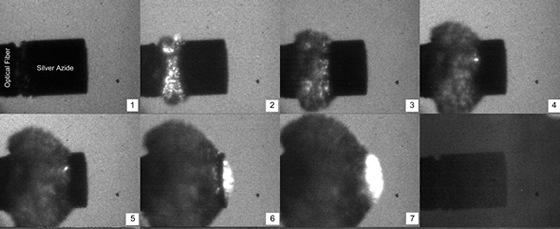Detonation(Registration:2008/4/1)
Detonation is a combustion wave propagating in a combustible medium faster than its sound speed, typically in order of km/s. Deflagration, which is a term representing ordinary combustion, usually propagates in cm/s to m/s range. Difference is how the combustible medium is ignited. In deflagration, heat conduction from flame front heats up unburned medium and then ignites it, so flame propagation speed is governed by heat conduction speed. In detonation, shock compression heats up unburned portion, thus the propagation speed can be as fast as shock propagation speed. Using detonative combustion in a heat engine, such as gas turbine engine, has an advantage in thermal efficiency compared to conventional isobaric combustor, because detonation involves compression process in itself. Recently, lots of research have been done for Pulse Detonation Engine (PDE), which utilizes detonative combustion and is aimed to replace not only conventional rocket engine, but also gas turbine engine. There are some studies on Micro PDE, but it has difficulties in downsizing detonative combustor. Just like micro combustor facing a quenching distance problem, detonation can not be driven in a medium of certain size or less, where it is called detonation limit or critical diameter. In this project, we are developing micro detonative combustor to achieve higher efficiency, especially utilizing solid/liquid detonation, that is explosives. Following is a series of ultra high speed photography showing detonation propagating in a silver azide pellet with only 1.5 mm diameter. Framing speed is 50ns/frame. Detonation is initiated by Nd:YAG laser and propagates in around 5km/s. Scattered bright spot, so-called "hot-spot" can be seen in initiation stage (frame 2). Detonation front has a certain curvature due to rarefaction wave, and can be recognized in frame 6.

VACUUM-PACKAGED MICRO FUEL REFORMER
FOR HIGH THERMAL EFFICIENCY AND LOW PACKAGE TEMPERATURE
ABSTRACT
A fully-microfabricated wafer-level vacuum package of a micro fuel reformer was designed, fabricated and tested. For thermal insulation, a high-temperature reactor is suspended by microfabricated tubes, in which fuel and reformed gas flow, and is vacuum-packaged by anodic bonding. Conductive heat loss through air in the package was investigated by making the packaging pressure as a parameter. The measured heat loss is 1.2 W at a reforming temperature of 240 °C, showing a potential to realize a micro fuel reformer with a thermal efficiency of 75 %. Also, the temperature of the package outside is as low as 60 °C, which is enough to install the micro fuel reformer in portable electronics.

